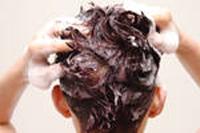|
Gentlemen prefer blondes... but gentlemen marry brunettes. Anita Loos |
|
Return back your hair with hair transplantation
The healthy condition of the hair depends, to a very large extent, on the intake of sufficient amounts of essential nutrients in the daily diet. Hair is made of keratin, a protein, which also makes up the nails and the outer layer of our skin. One of the primary cause of hair loss is a high amount of the male hormone, dihydrotestosterone (DHT) within the hair follicle. DHT is produced from testosterone in the prostate, various adrenal glands, and the scalp. After a period of time, an over abundance of DHT causes the hair follicle to degrade and shortens the active phase of the hair. Women require 60 grams, men 80 to 90 grams, adolescent boys and girls 80 to 100 grams of protein. It is supplied by milk, buttermilk, yogurt, soyabean, eggs, cheese, meat and fish. A deficiency of some of the B vitamins, of iron, copper and iodine may cause hair disorders like falling of hair and premature greying of hair. The chief difference in womens androgenic hair loss from mens (both are hormone related) is that women tend to experience thinning that occurs in no particular pattern or part of the scalp. Unlike men, the scalp may not actually be totally denuded of hair, just thin to the point where the scalp is visible. Like men, however, the resulting hair loss is generally irreversible. The effectiveness of medications used to treat alopecia depends on the cause of hair loss, extent of the loss and individual response. Generally, treatment is less effective for more extensive cases of hair loss. Minoxidil (Rogaine). This over-the-counter medication is approved for the treatment of androgenetic alopecia and alopecia areata. Minoxidil is a liquid that you rub into your scalp twice daily to regrow hair and to prevent further loss. Some people experience some hair regrowth or a slower rate of hair loss or both. Minoxidil is available in a 2 percent solution and in a 5 percent solution. New hair resulting from minoxidil use may be thinner and shorter than previous hair. But there can be enough regrowth for some people to hide their bald spots and have it blend with existing hair. New hair stops growing soon after you discontinue the use of minoxidil. If you experience minimal results within six months, your doctor may recommend discontinuing use. Side effects can include irritation of the scalp. Finasteride (Propecia). This prescription medication to treat male-pattern baldness is taken daily in pill form. Many people taking finasteride experience a slowing of hair loss, and some may show some new hair growth. Positive results may take several months. Finasteride works by inhibiting the conversion of testosterone into dihydrotestosterone (DHT), a hormone that shrinks hair follicles and is an important factor in male hair loss. Rare side effects of finasteride include diminished sex drive and sexual function. As with minoxidil, the benefits of finasteride stop if you stop using it. Frequently shampooing can dry out your hair and, therefore, must be followed by the use of a moisturizing conditioner. It is very important to work the conditioner through all of your hair and leave it in for three to five minutes. Again, many people misapply and misuse conditioner by not working it through to the ends of the hair and not leaving it on long enough. Excessive exposure to the sun can damage your hair by inducing oxidation of the sulfur molecules within the hair shaft, leaving the hair weak, brittle, dry and faded. People who bleach or lighten their natural hair color may also notice slight color changes in their hair when it is exposed to sun. Hair requires the same overall nutrition that the body does: plenty of fresh fruits and vegetables, grains and protein including lean meat and fish. Dietitians recommend foods high in biotin, including brown rice, bulgar, brewer's yeast, soybeans, green peas, lentils, oats, sunflower, seeds and nutritious nuts. Nutritionists advise healthy hair seekers to eat well-balanced diets that incorporate healthy proteins along with foods high in vitamins B, C, E, A and K. Hair instantly responds to the addition of protein-rich foods such as meats, eggs, cheese, seeds and nuts. Fish packs a double punch of protein combined with health building essential fatty acids and natural oils. We recommend you discuss your diet with a medical professional. Whether you have straight or curly hair depends on the shape of the cortex. If the cross section of the cortex is round you will have straight hair, if the cortex is oval shaped you will have curly or wavy hair. Hair that is dark and very visible is known as Terminal hair. Terminal hair is the hair that we refer to when talk about hair. Whether a hair is a fine vellus hair or a thick dark hair depends entirely on the follicle that is producing the hair. In balding men thick terminal hair is often replaced by fine vellus hair. This is a result of the hair producing equipment, the follicle, suffering physical damage and being unable to produce terminal hair. The average Caucasian person has 5 million hairs of which 100,000 - 150,000 are on the head. Blondes not only have more fun, they also have more hair, about 140,000 more than average, Brunettes have slightly higher than average hair about 105,000 hairs, and redheads have a little less than average about 90,000 hairs. About 90 percent of the hair on a person's scalp is growing at any one time. The growth phase lasts between two and six years. Ten percent of the hair is in a resting phase that lasts two to three months. At the end of its resting stage, the hair is shed. When a hair is shed, a new hair from the same follicle replaces it and the grow-ing cycle starts again.
Terms on this pageScalp Czech plastic surgery clinic
|

